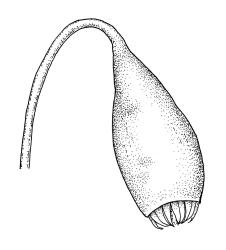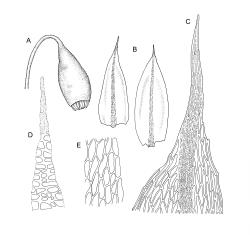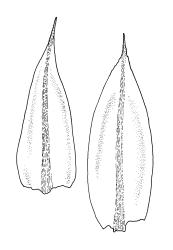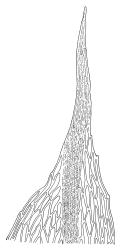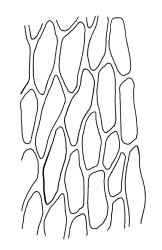- ≡ Bryum pendulum var. rutheanum Warnst., Verh. Bot. Vereins Prov. Brandenburg 14: 84 (1873)
- = Bryum pendulum (Hornsch.) Schimp., Coroll. Bryol. Eur. 70 (1856) nom. illeg.
- = Bryum cuneatum R.Br.bis, Trans. & Proc. New Zealand Inst. 31: 459 (1899)
Plants yellow- or brown-green, weakly lustrous, forming loose turves. Stems red-brown, c. (5–)10–30 mm, branching by subperichaetial innovation, beset below with moderately papillose brown rhizoids, in cross-section with 2–3 layers of thick-walled cortical cells and a distinct central strand. Leaves moderately crowded and larger at stem apices, erect-spreading when moist, becoming more erect when dry, ovate- or oblong-lanceolate, tapered to a slenderly acuminate apex, c. 1.8–2.2 × 0.7–0.8 mm (sometimes smaller on innovative branches) and with lamina c. 0.9 the total leaf length, concave, green throughout (except basal cells), weakly serrulate near apex but entire below, bordered by several rows of narrow but weakly differentiated cells, narrowly revolute, weakly decurrent; upper laminal cells rhombic-hexagonal to ± oblong, firm-walled (45–)51–60 × 15–18 µm and mostly 3–4:1, becoming longer (and merging with border) near apex, and longer (to c. 90 µm) and more oblong in lower leaf; marginal cells linear and ± thicker-walled to form a weakly defined border c. 5–6 cells wide and extending nearly to apex; basal cells ± shorter and broader, often red. Costa rather stout, usually red at base, excurrent. Brood bodies (including tubers) absent.
Synoicous. Perichaetia near base of plant; perichaetial leaves not differentiated. Setae c. (10–)20–35 mm, red-brown, cygneous just below capsule; capsules pendent, pyriform, 1.5–2.0 × c. 1.0 mm, with a weakly defined neck c. ⅓ the total length and scarcely wrinkled when dry; operculum conic. Exostome teeth yellow-brown, with adaxial lamellae joined by longitudinal or oblique thickenings; endostome adhering to the teeth; segments fragile in N.Z. material; cilia absent or rudimentary. Spores 21–36 µm (variable in a single capsule), nearly smooth.
Limpricht 1890–1895, p. 294; Crum & Anderson 1981, fig. 249; Smith 2004, fig. 181, 5–8.
SI: Marlborough (Kaikōura), Canterbury (Waiau River, Cave Stream), Otago (Waikouaiti River estuary, Naseby, Cardrona Valley, Lake Wanaka).
Bipolar. Widespread in the northern hemisphere.
On sand and silt at margins of streams and lakes. Collected once from a damp sand slack between sand hills in an estuary (at Waikouaiti River). Apparently common in abandoned gold sluicing channels at Naseby. From near sea level to 730 m. A frequent association with Drepanocladus aduncus suggests a preference for calcareous substrates.
The most striking macroscopic feature of this species is a peristome that appears single under the hand lens due to the adherence of the endostomal segments to the adaxial surface of the exostome teeth. The rather short (c. 2 mm), pyriform capsules are somewhat narrowed (but not constricted) at the mouth, providing an additional aid to recognition. Under the microscope the presence of longitudinal and oblique thickenings that extend between adjacent exostomal lamellae make this species unmistakable in a N.Z. context. The inter-lamellar thickenings result in the inner surface of the tooth appearing as a highly irregular lattice. Bryum algovicum var. rutheanum is not recognisable in a sterile condition.
New Zealand material has capsules somewhat shorter than descriptions in northern hemisphere floras suggest (cf. Crum & Anderson 1981, p. 542; Limpricht 1890–1895, p. 293). Crundwell (1970) indicated that the preferred name for synoicous forms of this species is B. algovicum var. rutheanum (Warnst.) Crundw. New Zealand material appears to be consistently synoicous and Crundwell's view is adopted here. Crum & Anderson (1981) presented an argument in favour of recognising a single inclusive taxon (B. algovicum Müll.Hal.) of variable sexuality.
The type material of B. cuneatum R.Br.bis was cited as a doubtful species by Ochi (1984), who referred the type to "B. algovicum or one of its allies." This collection is the sole Marlborough L.D. record of B. algovicum var. rutheanum. The gametophytic features of the type specimen (including its synoicous sexuality) and general capsule form are consistent with the present species. The precise nature of the exostome teeth ornamentation is not observable in the type, due to immaturity.
Sterile shoots or stems with elongate innovations could be confused with B. pseudotriquetrum, due to the decurrent leaf bases; however, the nature of the leaf apex and costae (more acuminate and elongate) differs from that species. Bryum amblyodon is another species with decurrent leaf bases and long-excurrent costae; the differences between B. algovicum var. rutheanum and B. amblyodon are discussed under the latter species.



